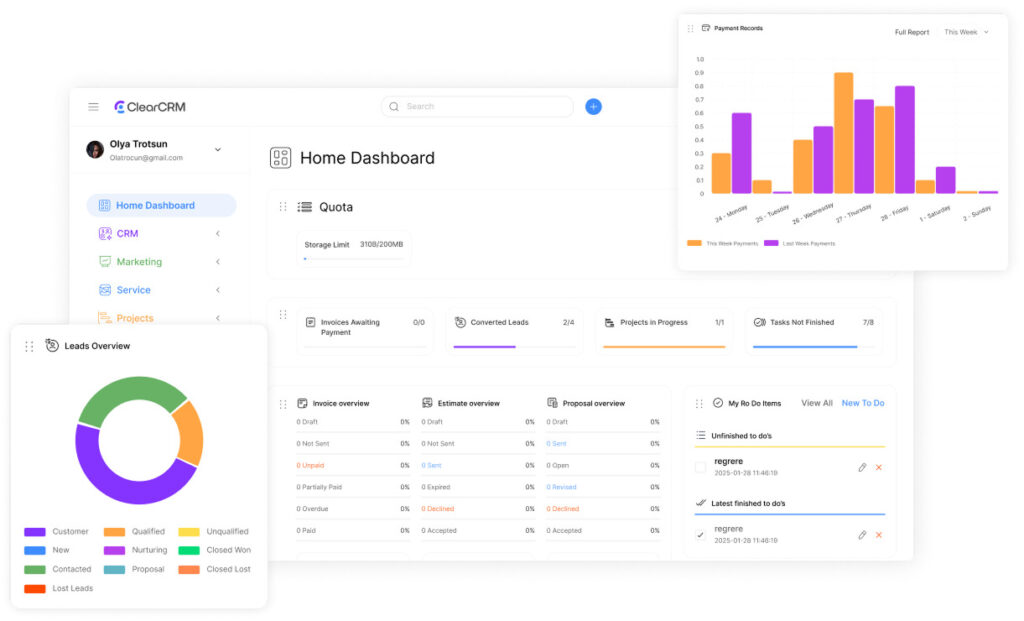Project Template: Consulting Engagement Tracker Template
Additionally, organizations using structured client management systems report 45% higher project success rates compared to those relying on scattered documentation. Clearly, this gap highlights a critical challenge in professional services: turning chaotic workflows into measurable results.
Therefore, for decision-makers overseeing complex initiatives, fragmented communication and unclear expectations often derail progress. Undoubtedly, a specialized tool designed to centralize client interactions, milestones, and feedback creates clarity where disorganization once thrived. Finally, it transforms scattered emails, meetings, and deliverables into a unified action plan.
Also, this system directly addresses three pain points: missed deadlines due to poor visibility, misaligned stakeholder priorities, and inconsistent client updates. So, by mapping every touchpoint and milestone, teams eliminate redundant efforts while maintaining accountability. However, professionals using similar frameworks complete projects 22% faster on average while improving client retention.
Indeed, the solution’s real power lies in its adaptability. Similarly, whether managing multiple stakeholders or navigating shifting project requirements, the structure remains consistent. Likewise, teams gain immediate insights into resource allocation, potential bottlenecks, and progress metrics—all through a single interface.
Key Takeaways
- Centralized tracking systems increase project success rates by 45%
- Structured frameworks reduce timeline overruns by 22% on average
- Real-time visibility improves stakeholder alignment and accountability
- Unified interfaces eliminate communication gaps across teams
- Customizable features adapt to diverse client needs and industries
Overview and Importance of Consulting Engagement Tracking

However, effective project oversight requires more than task lists and deadlines. Conversely, centralized tracking systems act as the backbone of successful initiatives, offering real-time insights into stakeholder interactions and progress metrics. Nevertheless, this approach transforms fragmented communication into actionable strategies that align teams and expectations.
Foundations of Strategic Project Oversight
Still, professional teams use structured tracking to map client needs and potential risks early. Yet, systematic documentation identifies conflicting priorities before they delay timelines. Thus, teams that implement these systems resolve issues 40% faster while maintaining compliance with regulatory requirements.
Advantages of Comprehensive Documentation
Detailed records provide three core benefits:
- Proof of stakeholder communication for audits
- Early detection of scope changes impacting deadlines
- Data-driven insights for process optimization
Namely, organizations using these methods report 35% fewer client disputes due to clear documentation. Next, the approach also creates reusable frameworks for future projects, reducing planning time by up to 50%.
Defining the Consulting Engagement Tracker Template
Importantly, structured frameworks transform client management by converting scattered data into strategic assets. Overall, this system acts as a living document that evolves with each phase of collaboration, ensuring alignment across teams and priorities.
Core Functionality Explained
Crucially, the framework serves as a centralized hub for critical information. Then, it consolidates contact details, communication histories, and decision-making patterns. Afterward, professionals use it to monitor participation levels across meetings, feedback cycles, and approval processes.
Subsequently, advanced versions integrate analytics to identify patterns in stakeholder behavior. Significantly, this enables teams to predict potential delays or conflicts before they escalate. In addition, organizations report 30% faster conflict resolution when using these predictive features.
Essential Structural Features
Let’s look at an example: four pillars form the foundation of effective systems:
- Customizable fields for industry-specific requirements
- Visual dashboards showing participation trends
- Automated alerts for milestone deadlines
- Exportable reports for client reviews
As a result, these components work together to create transparency across complex initiatives. Not only that, teams can scale the tool from basic spreadsheets to enterprise software, maintaining consistency across small updates and multi-year transformations.
In conclusion, real-time updates ensure all members access current project data simultaneously. After that, this eliminates version control issues that traditionally plague cross-departmental collaborations.
How to Implement the Consulting Engagement Tracker Template

Implementing structured tracking systems bridges the gap between strategy and execution. Teams gain immediate visibility into progress while maintaining alignment across all parties. This approach turns complex workflows into manageable actions.
Step-by-Step Guide to Setting Up Your System
Four core steps transform raw data into actionable insights. Each phase builds on the previous to create a cohesive management framework:
| Step | Key Actions | Outcome |
|---|---|---|
| 1. Solution Selection | Assess stakeholder volume, budget, and required features | Optimal platform matching project needs |
| 2. Stakeholder Onboarding | Document contact details, influence levels, and communication preferences | Complete visibility into participant roles |
| 3. Interaction Logging | Record meetings, emails, and feedback with timestamps | Comprehensive engagement history |
| 4. Insight Application | Generate reports and adjust strategies based on trends | Data-driven decision making |
Tips to Ensure Accurate Data Recording
Reliable information forms the foundation of effective tracking. These methods maintain data integrity:
- Standardize entry protocols: Use dropdown menus for consistent categorization
- Automate documentation: Integrate with email clients and calendar tools
- Schedule audits: Verify records weekly to catch discrepancies
Teams that follow these guidelines reduce data errors by 38% compared to manual methods. Proper training ensures all members understand confidentiality requirements and update procedures.
Customizing Your Template for Enhanced Project Management
Generic tracking tools often create more problems than they solve. Teams waste time adapting rigid systems to dynamic workflows. Strategic customization bridges this gap, transforming basic frameworks into precision instruments for client success.
Tailoring Features to Fit Specific Needs
Effective adaptation starts with analyzing past initiatives. Professionals review project histories to identify patterns in client communication and resource allocation. This reveals which template elements need expansion or simplification.
Industry-specific requirements demand focused adjustments. Legal teams might add compliance checkpoints, while marketing groups prioritize campaign metrics. Custom fields capture niche data points without cluttering core workflows.
Automation plays a critical role in scaled operations. Teams set triggers that alert stakeholders about approaching deadlines or budget thresholds. Integrated dashboards display real-time progress across multiple engagement streams.
- Role-based access controls maintain security while enabling collaboration
- Historical data analysis informs future template improvements
- Cross-platform integration eliminates duplicate data entry
The best systems balance adaptability with consistency. A healthcare consultancy’s template might emphasize regulatory documentation, while a tech firm prioritizes sprint cycles. Both maintain standardized reporting formats for easy cross-team analysis.
Organizations using customized frameworks resolve client issues 27% faster than those relying on generic tools. This approach turns static documents into living systems that evolve with each new challenge.
Integrating Stakeholder Engagement Tracking

Successful initiatives require more than task management—they demand precise oversight of human dynamics. A well-designed system maps influence patterns and interaction histories to reveal critical insights. This approach transforms fragmented conversations into strategic roadmaps.
Strategies for Monitoring Stakeholder Interactions
Effective tracking starts with categorizing participants by their involvement levels. Five distinct tiers shape engagement strategies:
- Leading: Actively drives decisions (weekly check-ins)
- Supporting: Backs initiatives (biweekly updates)
- Neutral: Requires evidence-based persuasion
- Resistant: Needs conflict resolution plans
- Unaware: Demands education campaigns
Teams using this tiered system resolve conflicts 31% faster by addressing concerns before escalation. Automated sentiment analysis tools help detect shifting attitudes across email threads and meeting notes.
Using Insights to Drive Effective Communication
Data-driven outreach prevents misalignment. High-influence stakeholders receive personalized briefings, while neutral parties get case studies demonstrating project benefits. Three tactics maximize impact:
- Match message frequency to engagement tier
- Use preferred channels (email vs. in-person)
- Align content with decision-making authority
Real-time dashboards highlight relationship health indicators, from response times to feedback tone. This visibility lets teams strengthen weak connections before deadlines approach. Organizations report 28% fewer delays when using these predictive insights.
Leveraging Technology: Tools & Software for Engagement Tracking
Modern project leaders face a critical choice when organizing stakeholder data: basic spreadsheets or specialized platforms. This decision impacts efficiency, scalability, and strategic outcomes.
Spreadsheet Solutions vs. Dedicated Stakeholder Software
Spreadsheets serve small teams managing limited interactions. They offer:
- Low-cost setup with familiar interfaces
- Manual data entry for basic reporting
- Customizable columns for simple tracking
Dedicated software becomes essential for complex initiatives. These platforms provide:
- Automated interaction logging across channels
- Predictive analytics for risk detection
- Real-time dashboards showing participation trends
| Feature | Spreadsheets | Software |
|---|---|---|
| Stakeholder Capacity | Up to 20 participants | Unlimited teams |
| Reporting Speed | Manual analysis | One-click exports |
| Integration | Limited | Email, calendars, CRMs |
Teams handling multi-phase projects benefit most from advanced tools. Cloud-based systems enable remote updates and centralized document storage. Companies using specialized platforms reduce reporting time by 65% compared to manual methods.
Four factors determine the right choice:
- Number of active stakeholders
- Frequency of status updates
- Required security protocols
- Budget for tech investments
Best Practices for Using the Consulting Engagement Tracker Template

Precision in data management separates thriving teams from those drowning in disorganization. A 2023 industry study revealed that 72% of project delays stem from outdated records or conflicting versions of truth. Systematic approaches prevent these costly errors while building stakeholder trust.
Maintaining Up-to-Date Information and Consistency
Centralized systems demand disciplined upkeep. Three protocols safeguard data reliability:
- Automated validation checks during entry
- Cross-team terminology alignment workshops
- Biweekly accuracy audits with error resolution
Teams using standardized formats reduce data reconciliation time by 41%. Cloud-based platforms enable real-time updates across departments, eliminating version conflicts. A financial services firm achieved 99.8% record accuracy by implementing role-based update permissions and mandatory field completion.
“Consistency turns raw data into strategic assets. Our team resolved 80% of client disputes within 48 hours after adopting unified documentation standards.”
Analyzing Feedback to Refine Your Process
Effective teams treat stakeholder input as growth fuel. Structured analysis involves:
- Categorizing feedback by urgency and impact
- Mapping suggestions to measurable outcomes
- Testing improvements in controlled cycles
Sentiment analysis tools now detect subtle shifts in communication tone, alerting teams to brewing concerns. Organizations conducting monthly feedback reviews report 33% higher client retention rates. One healthcare provider reduced report preparation time by 55% after analyzing recurring client requests.
Implementation checklists ensure continuous improvement:
- Schedule quarterly process evaluation meetings
- Compare feedback trends against project metrics
- Update tracking protocols based on proven results
Real-World Examples and Use Cases
Practical applications demonstrate how structured systems turn complex collaborations into measurable results. These scenarios reveal patterns that guide teams toward smarter decisions and stronger outcomes.
From Planning to Execution
A public library coordinator used the framework to organize an Environmental Month initiative. They mapped stakeholder groups including staff, patrons, and nonprofit partners. Contact details and communication preferences were logged to prioritize outreach based on influence levels.
The system flagged key decision-makers needing weekly updates while automating reminders for less involved participants. This approach reduced planning time by 33% and increased event attendance by 18% compared to previous years.
Industry-Specific Adaptations
Healthcare providers added compliance checklists to their tracking systems, while tech firms integrated sprint timelines. One financial services team used the template to manage 47 regulators across eight jurisdictions, cutting approval delays by 41%.
These examples prove adaptable frameworks work across sectors. Teams maintain core tracking principles while adding industry-specific fields for precise project oversight. The library case shows even non-corporate groups achieve better results through systematic engagement.

